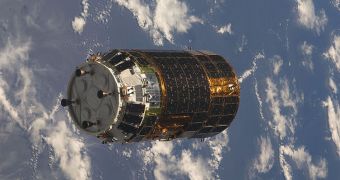Officials with the Japanese Aerospace Exploration Agency (JAXA) announce that the planned launch date for the HTV2 unmanned cargo ship has been changed to 12:37 am EST (17:37 GMT) on Saturday, January 22.
This is the second H-II Transfer Vehicle (HTV) constructed in Japan, and also the second spacecraft the country is poised to launch to the International Space Station (ISS). Initially, the cargo ship was scheduled to launch today, January 20
However, a forecast of thick clouds with freezing layers above the launch site at the Tanegashima Space Center in southern Japan has forced mission controllers to delay the flight by two days.
Unlike the American-built space shuttles, which spend two days chasing the international facility in low-Earth orbit (LEO), the HTV is planned to spend an entire week. With the delay, JAXA will only have five days to get the space capsule to its destination.
Officials at the agency are convinced that this is entirely doable, and this is why they have not yet changed a planned January 27 grappling maneuver, which is to be performed with the station's Canadarm 2 robotic arm.
In preparation for the arrival of HTV-2, called Kounotori 2 (Japanese for white stork), Expedition 26 flight engineers Catherine Coleman (NASA) and Paolo Nespoli (ESA) had robotics training yesterday.
Together with Expedition 26 Commander Scott Kelly (NASA), they practiced using the Canadarm 2 to grapple the HTV as it flies past the ISS. The capsule has no automated docking systems, and so it needs to be captured manually.
The HTV itself costs about $220 million each, JAXA announced. With its successful deployment, Japan has entered a very select group of nations, which have the ability to deliver cargo to the $100-billion ISS via unmanned cargo ships.
The Russian Federation has its Progress and Soyuz capsules, while the European Union has its Automated Transfer Vehicles (ATV).
During the first HTV flight, astronauts aboard the ISS only had 99 seconds to grapple the spacecraft before it went to far to be retrieved. The new flight is expected to provide Expedition 26 crew members with about the same time frame, Space Fellowship reports.

 14 DAY TRIAL //
14 DAY TRIAL //